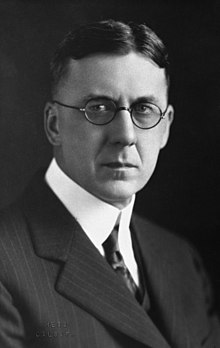John Edward Brownlee | |
|---|---|
 | |
| 5th Premier of Alberta | |
| In office November 23, 1925 – July 10, 1934 | |
| Monarch | George V |
| Lieutenant Governor | William Egbert William L. Walsh |
| Preceded by | Herbert Greenfield |
| Succeeded by | Richard G. Reid |
| Member of the Legislative Assembly of Alberta for Ponoka | |
| In office December 9, 1921 – August 22, 1935 | |
| Preceded by | Percival Baker |
| Succeeded by | Edith Rogers |
| Alberta Provincial Secretary | |
| In office June 15, 1926 – July 10, 1934 | |
| Preceded by | George Hoadley |
| Succeeded by | Richard G. Reid |
| In office 1923 – November 23, 1925 | |
| Preceded by | Herbert Greenfield |
| Succeeded by | George Hoadley |
| Attorney-General of Alberta | |
| In office August 31, 1921 – June 5, 1926 | |
| Preceded by | John R. Boyle |
| Succeeded by | John Lymburn |
| Personal details | |
| Born | August 27, 1883 Port Ryerse, Ontario, Canada |
| Died | July 15, 1961 (aged 77) Calgary, Alberta, Canada |
| Political party | United Farmers of Alberta |
| Spouse | Florence Edy |
| Children | 2 |
| Alma mater | University of Toronto |
| Occupation |
|
| Signature |  |
John Edward Brownlee, QC (August 27, 1883 – July 15, 1961) was the fifth premier of Alberta, serving from 1925 until 1934. Born in Port Ryerse, Ontario, he studied history and political science at the University of Toronto's Victoria College before moving west to Calgary to become a lawyer. His clients included the United Farmers of Alberta (UFA); through his connection with that lobby group, he was involved in founding the United Grain Growers (UGG).
After the UFA entered electoral politics and won the 1921 election, new premier Herbert Greenfield asked Brownlee to serve as his attorney-general. Brownlee agreed and was elected to the Legislative Assembly of Alberta in a by-election in the riding of Ponoka. As attorney-general, he was an important member of Greenfield's government. He was closely involved in its most important activities, including efforts to better the lot of farmers living in Alberta's drought-ridden south, divest itself of money-losing railways, and win jurisdiction over natural resources from the federal government. When a group of UFA backbenchers grew frustrated with Greenfield's weak leadership, they asked Brownlee to replace him. Brownlee eventually agreed, and became premier in 1925.
Brownlee enjoyed early success as premier: he handily won the 1926 election, signed an agreement with the federal government transferring control over Alberta's natural resources to its provincial government, sold the struggling government railways to the Canadian National and Canadian Pacific railway companies, and ran a series of balanced budgets. Things became more difficult with the advent of the Great Depression. Brownlee was unable to restore the province to prosperity in the face of a global economic crisis, and reluctantly ran budget deficits. Political radicalism increased, and Brownlee found his orthodox approach to political economy under attack.
In 1934, Vivian MacMillan, a family friend, sued Brownlee for seduction. Brownlee denied any sexual relationship, but the jury found in MacMillan's favour. Though the judge disregarded the jury's verdict, the trial's lurid testimony and the stigma resulting from the jury's finding forced Brownlee's resignation as premier.
He ran for re-election in Ponoka in the 1935 provincial election but was defeated, as William Aberhart's Social Credit League swept the province. Once out of politics, Brownlee resumed the practice of law and joined the management of the UGG, serving as its president and general manager from 1948 until shortly before his death in 1961.